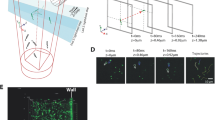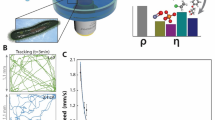Abstract
RATHER definite spatial patterns are observed in cultures of swimming microorganisms which are heavier than water and which tend to propel themselves toward the upper surface in response to some external stimulus; for example, gravity, light and chemicals. These patterns are characterised by falling fingers containing the organisms and are maintained by return upward swimming of the organisms. The patterns have been termed ‘bioconvection’ patterns1 and have been known since 18482; they are found in bacterial, flagellate3,4, plankton5 and ciliate6 cultures.
This is a preview of subscription content, access via your institution
Access options
Subscribe to this journal
Receive 51 print issues and online access
$199.00 per year
only $3.90 per issue
Buy this article
- Purchase on SpringerLink
- Instant access to full article PDF
Prices may be subject to local taxes which are calculated during checkout
Similar content being viewed by others
References
Platt, J. R., Science N.Y., 133, 1766 (1961).
Wager, H., Proc. R. Soc., Lond B. 83, 94 (1911).
Gittleson, S. L., and Jahn, T. L., Expl. Cell Res., 51, 579 (1968).
Robbins, N. J., Bull. Torrey Bot. Club, 79, 107 (1952).
Teodoresco, E. C., and Angelesco, E., Kolloid Z., 97, 216 (1941).
Loefer, J. B., and Mefferd, R. B., jun., Am. Nat., 86, 325 (1952).
Winet, H., and Jahn, T. L., Biorheology, 9, 87 (1972).
See for example S., Chandrasekhar, Hydrodynamic and Hydromagnetic Stability, Ch. 10 (Oxford University Press, 1961).
Plesset, M. S., and Whipple, C. G., Physics of Fluids (in the press).
Author information
Authors and Affiliations
Rights and permissions
About this article
Cite this article
PLESSET, M., WINET, H. Bioconvection patterns in swimming microorganism cultures as an example of Rayleigh-Taylor instability. Nature 248, 441–443 (1974). https://doi.org/10.1038/248441a0
Received:
Revised:
Issue date:
DOI: https://doi.org/10.1038/248441a0
This article is cited by
-
Homotopy analysis on the bio-inspired radiative magnesium and iron oxides/blood nanofluid flow over an exponential stretching sheet
Computational Particle Mechanics (2023)
-
Magnetohydrodynamic second-grade nanofluid flow containing nanoparticles and gyrotactic microorganisms
Computational and Applied Mathematics (2018)
-
Application of some droplet sedimentation theories to layered erythrocyte suspensions
Cell Biophysics (1989)



